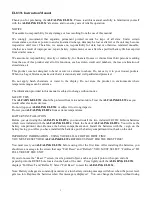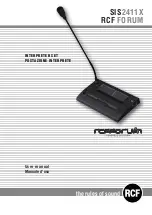
Program P2: OSC/Pitch 2–9: Pitch EG
57
2–9a: EG Reset
AMS (EG Reset AMS)
[List of AMS Sources]
This selects an AMS source to reset the EG to the start
point. For instance, you can use a tempo-synced LFO
to trigger the EG in a repeating rhythm. This reset is in
addition to the initial note-on, which always causes the
EG to start.
For a list of AMS sources, see “AMS (Alternate
Modulation Source) List” on page 967.
Threshold
[–99…+99]
This sets the AMS level which will trigger the EG reset.
Among other things, you can use this to adjust the
exact point in an LFO’s phase at which the EG will be
reset, effectively controlling its “groove” against other
rhythmic effects.
When the threshold is
positive
, the EG triggers when
passing through the threshold moving upwards. When
the threshold is
negative
, the EG triggers when
passing through the threshold moving downwards.
Note
: with some LFO shapes, and with faster LFO
speeds, the LFO may not always reach the extreme
values of +99 or -99. In this case, setting the
Threshold
to these values may cause inconsistent behavior, or
may mean that the EG doesn’t reset at all. If this
happens, reduce the
Threshold
until the EG triggers
consistently.
2–9b: Envelope
Pitch EG
An envelope creates a modulation signal by moving
from one level to another over a specified time, and
then moving to another level over another period of
time, and so on.
The parameters below let you set four levels, the
amount of time it takes to go from each of the levels to
the next, and the shape (from linear to curved) of each
transition.
Level
Each of the four levels can be either positive or
negative.
Positive
levels will make the pitch (or other AMS
destination) go up from its programmed value;
negative
levels will make it go down.
Note that, unlike the Filter and Amp EGs, the Pitch
EG’s Sustain Level is always 0.
Start
[–99…+99]
This sets the initial EG level, at note-on.
Attack
[–99…+99]
This sets the level at the end of the Attack time.
Break
[99…+99]
Break, short for Break Point, sets the level at the end of
the Decay time.
Release
[–99…+99]
This sets the level at the end of the Release time.
Time
Higher values mean longer times, as shown below:
Attack
[00…99]
This sets how long the EG takes to move from the Start
level to the Attack level.
The minimum attack time is 2/3 of a millisecond–as
fast as the most punchy of classic analog synths.
For the fastest possible attack time, you can set the
Start level to +99; in this case, the EG will start
instantaneously at its maximum value.
Decay
[00…99]
This sets the time it takes to move from the Attack level
to the Break level.
Slope
[00…99]
This sets how long the EG takes to move from the
Break level to the Sustain level (which for the Pitch EG
is always 0). Once it reaches the Sustain, the EG will
stay there until note-off, unless it is reset via AMS.
Release
[00…99]
This sets how long it takes the EG to move from the
Sustain level to the Release level.
Curve
For the sake of simplicity, most of the diagrams in this
manual show envelopes as being made out of straight
lines. In actuality, though, envelopes are more likely to
be made out of curves.
In other words, each segment’s level will change
quickly at first, and then slow down as it approaches
the next point. This tends to sound better than straight,
linear segments.
Note-on or reset
Note-off
Attack
Time
Start
Level
Decay
Time
Release
Time
Release
Level
Attack
Level
Change to
Pitch
Sustain Level
(Always 0)
Time
Break
Level
Slope
Time
EG Value
Actual Time
00
0.667 ms
10
10 ms
20
44 ms
30
104 ms
40
224 ms
50
464 ms
60
944 ms
70
1.8 seconds
80
3.8 seconds
90
10.9 seconds
99
87.3 seconds
Содержание Electronic Keyboard
Страница 1: ...Parameter Guide Parameter Guide ...
Страница 2: ......
Страница 180: ...Program mode EXi 170 ...
Страница 290: ...EXi STR 1 Plucked String 280 ...
Страница 572: ...Sequencer mode 562 ...
Страница 700: ...Global mode 690 ...
Страница 751: ...Insert Effects IFX1 IFX12 Routing 741 Fig 2 3a Fig 2 3b ...
Страница 902: ...Effect Guide 892 ...
















































